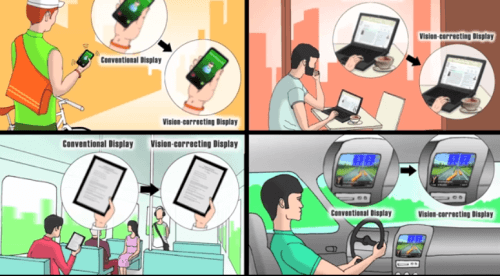Sharp vision without glasses: Smartphone screens and tablet computers adjust themselves to the vision of their users

More than 40% of Americans in their 40s need reading glasses. That number jumps to nearly 70% over the age of 80. "As we age, vision problems play a more important role in our lives," says Gordon Wetzenstein, a professor of electrical engineering at Stanford University.
But glasses and contact lenses are not always an ideal solution. Farsighted people, for example, do not need glasses to see the traffic on the road while driving, but they do need them to read data from the speedometer or GPS device. According to Wetzenstein, the best solution in such cases would be a vision correction screen, a screen that will put the glasses on for you.
Wetzenstein and his colleagues at the Massachusetts Institute of Technology (MIT), where he previously worked, and at the University of California, Berkeley, developed just such a screen. A vision correction screen differs from a normal high definition screen of a smartphone or tablet in two features. The first difference, which is also very cheap to implement, is the transparent screen cover pierced with a network of holes. The second difference is the distortion of the image displayed on the screen according to the prescription of the viewer's glasses. Algorithms integrated into the device's software are able to determine the viewer's position relative to the screen and perform the distortion. When the distorted image passes through the grid of holes in the glass that covers the screen, the hardware-software combination produces errors on the screen that offset the visual errors of the eye so that the final result obtained is a sharp image. Such a screen can correct myopia, farsightedness, astigmatism ("cylinder") and more complex vision problems. The group presented this work at the SIGGRAPH conference held in August 2014 in Vancouver, Canada.
Wetzenstein claims that informal tests conducted on a small number of users showed that this technology does work, but also that large-scale studies are needed to improve it. During these studies, the researchers plan to add an interface that will allow the focus of the screen to be manually adjusted. According to Wetzenstein, the technology could bring a boon to people in developing countries where it's easier to get a smartphone than a prescription for glasses.

4 תגובות
Experts warn, smartphones cause myopia:
http://www.ynet.co.il/articles/0,7340,L-4641305,00.html
The problem begins when the focus of the eye remains on the same object, at the same distance, for a long time. That is why it is highly recommended to take breaks, and change the focus by looking at objects at different distances.
There is no special effect to a computer or television screen compared to concentrating on anything else.
Tomer
I have read studies that show that there is no connection between computer use, and reading in the dark, and persistent vision problems.
Does anyone know to what extent today's vision problems are related to the issue of working in front of a computer and smartphones? Did 500 years ago for example everyone have normal vision? (Or at least to 90% of the population?)